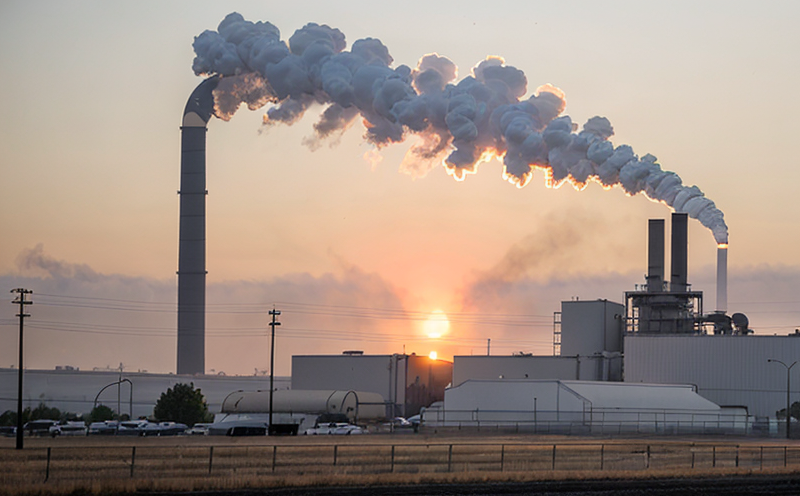DIN EN 13284 Dust Emission Testing of Industrial Sources
The DIN EN 13284 standard provides a comprehensive framework for assessing dust emissions from industrial sources. This method is crucial in ensuring compliance with environmental regulations and promoting cleaner industrial practices. The test covers the determination of airborne dust concentration, particle size distribution, and mass emission rates under various operating conditions.
Quality managers and R&D engineers rely on this testing to ensure that their processes are efficient and environmentally friendly. Compliance officers use these data points to demonstrate adherence to relevant environmental legislation such as ISO 14001 and EU Emissions Trading System (EU ETS). The test is particularly important for industries like metalworking, woodworking, mining, and chemical processing.
The primary goal of DIN EN 13284 testing is to quantify the amount of dust released into the atmosphere during manufacturing or processing activities. This helps in identifying potential sources of air pollution and allows for the implementation of corrective measures to minimize emissions. The test parameters include temperature, humidity, wind speed, and atmospheric pressure, which can significantly affect dust dispersion.
Preparation steps before testing involve setting up the sampling site according to specified guidelines in the standard. Sampling devices such as cyclones or impactors are used to collect airborne particles for analysis. The specimens collected undergo rigorous quality checks to ensure they represent actual emissions accurately.
The methodology outlined in DIN EN 13284 specifies several key procedures:
- Sampling techniques
- Sample conditioning and preparation
- Data processing and reporting
The test results are critical for making informed decisions about process improvements aimed at reducing dust emissions. By adhering to DIN EN 13284, industrial facilities can ensure they meet stringent environmental standards while maintaining operational efficiency.
A table summarizing the key steps in the testing procedure is provided below:
| Step | Description |
|---|---|
| Sampling Site Setup | Ensure proper placement of sampling devices based on operational conditions. |
| Sample Collection | Capture airborne particles using appropriate collection methods. |
| Sample Conditioning | Condition specimens to standardize test conditions and improve accuracy. |
| Data Processing | Analyze collected data for emission rates and particle size distribution. |
| Reporting | Draft comprehensive reports detailing findings and recommendations. |
The DIN EN 13284 standard ensures that all steps are conducted in a controlled manner to yield reliable results. Compliance officers can use these data points to make strategic decisions regarding plant upgrades or operational changes. R&D engineers benefit from this testing by identifying areas for improvement and innovation.
Quality managers rely on DIN EN 13284 dust emission tests to maintain high standards of environmental responsibility within their organizations. By adhering strictly to the prescribed methodologies, they can ensure that their industrial processes are both efficient and compliant with international standards.
Scope and Methodology
The scope of DIN EN 13284 dust emission testing includes the determination of airborne dust concentration, particle size distribution, and mass emission rates from industrial sources. The method covers various types of emissions such as those produced by metalworking processes, woodworking operations, mining activities, and chemical processing plants.
The methodology involves several key steps:
- Sampling site setup
- Sample collection using appropriate devices like cyclones or impactors
- Conditioning specimens for standardized testing
- Data analysis to determine emission rates and particle size distributions
- Reporting findings comprehensively
The testing ensures that industrial processes are conducted in an environmentally responsible manner. Compliance officers use these data points to demonstrate adherence to relevant environmental regulations such as ISO 14001 and EU Emissions Trading System (EU ETS).
| Sampling Site Setup | Description |
|---|---|
| Cyclones or impactors placement | Ensure proper positioning based on operational conditions. |
| Airflow monitoring | Measure airflow to ensure consistent sampling. |
| Environmental factors consideration | Incorporate temperature, humidity, wind speed, and atmospheric pressure data. |
The collected specimens undergo rigorous quality checks before analysis. This ensures that the results accurately reflect actual emissions levels. The testing procedure is designed to be flexible enough to accommodate different industrial processes while maintaining high standards of accuracy and reliability.
DIN EN 13284 dust emission tests are essential for industries seeking to minimize their environmental impact. By adhering strictly to the prescribed methodologies, these facilities can ensure they meet stringent environmental standards while maintaining operational efficiency.
Industry Applications
- Metalworking: Detects dust emissions from cutting tools and grinding operations.
- Woodworking: Identifies airborne particles generated during sawing, planing, and sanding processes.
- Mining: Measures dust released during drilling, crushing, and conveying activities.
- Chemical Processing: Assesses emissions from various manufacturing stages involving volatile organic compounds (VOCs).
Dust emission testing using DIN EN 13284 is a critical tool for industries that produce significant amounts of airborne particulate matter. The test helps in identifying sources of air pollution and allows for the implementation of corrective measures to minimize emissions.
Quality managers use these data points to ensure their processes are efficient and environmentally friendly. Compliance officers rely on these results to demonstrate adherence to relevant environmental legislation such as ISO 14001 and EU Emissions Trading System (EU ETS).
Environmental and Sustainability Contributions
- Dust emission testing reduces air pollution by identifying sources of airborne particulate matter.
- Minimizes health risks associated with exposure to fine dust particles.
- Supports sustainable development goals by promoting cleaner industrial practices.
- Promotes compliance with international environmental standards such as ISO 14001 and EU ETS.
Dust emission testing using DIN EN 13284 is a crucial step in maintaining high standards of environmental responsibility within industrial facilities. By adhering strictly to the prescribed methodologies, these organizations can ensure they meet stringent environmental standards while maintaining operational efficiency.
These tests play a vital role in reducing air pollution and promoting cleaner industrial practices. They help identify sources of airborne particulate matter and allow for the implementation of corrective measures aimed at minimizing emissions. As such, they contribute significantly to sustainability efforts across various sectors.





